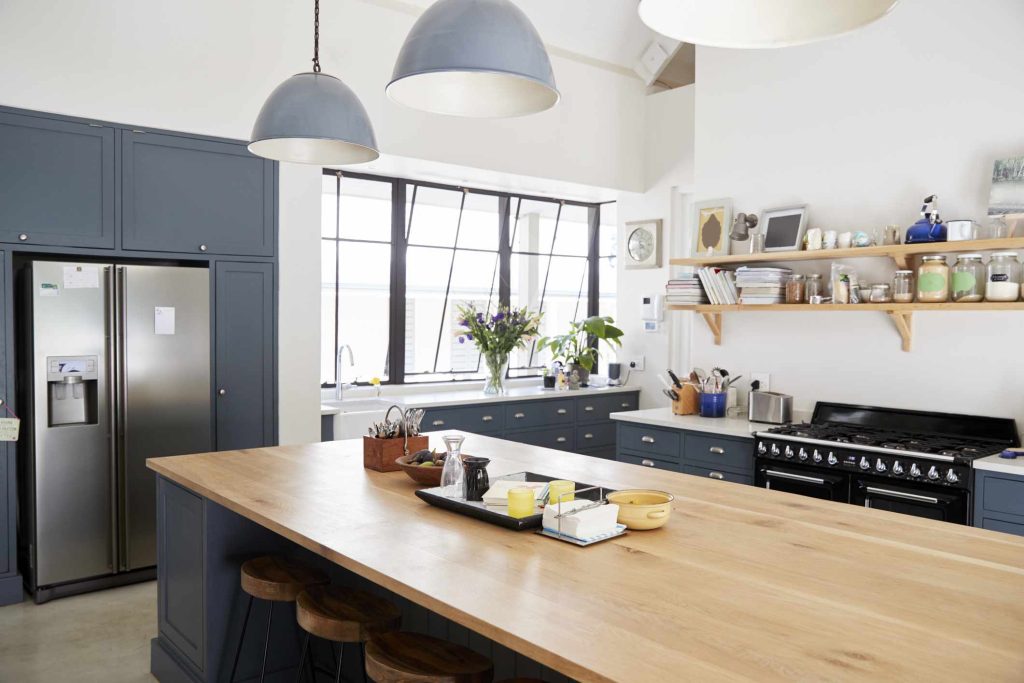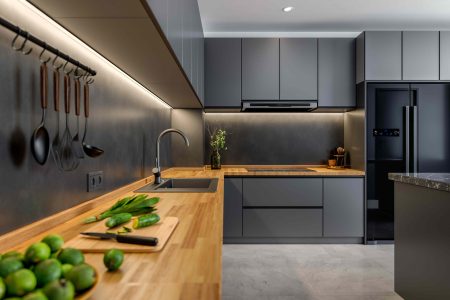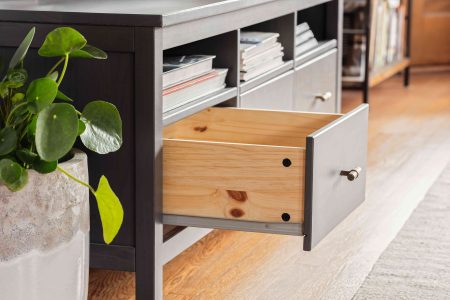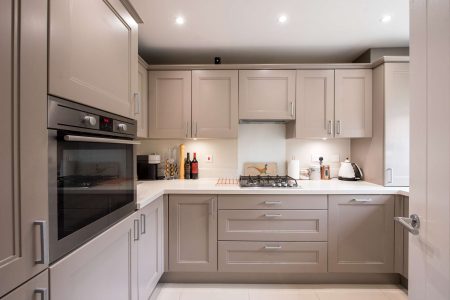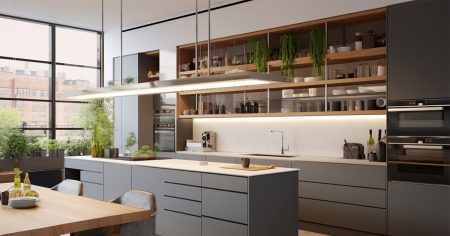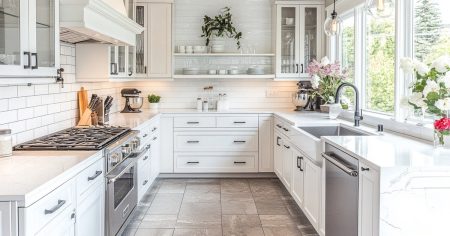Kitchen islands are popular additions because they increase countertop and storage space and act as social gathering points.
Kitchen islands cost an average of $19,250, though basic islands cost $3,000 to $6,000.
Meet the Expert
- Katie Newcomb is an interior designer and co-owner of Kith & Kin Interior Design.
- Elizabeth Johnson is Lead Designer and the owner of Liz Johnson Design Studio.
- Alan Berman is an architect and the founder and Principal of Archetype Architecture.
Average Cost
Kitchen island costs start with basic islands built from stock or semi-custom cabinet bases and with no utilities. Basic kitchen islands cost an average of $4,500.
High-end kitchen islands using premium materials and with extra features like cooktops and wine coolers cost an average of $35,000.
| Low | High | Average | |
| Basic | $3,000 | $6,000 | $4,500 |
| Upper Basic | $14,000 | $20,000 | $17,000 |
| Mid-Range | $17,000 | $24,000 | $20,500 |
| Premium | $20,000 | $50,000 | $35,000 |
| Total Average | $13,500 | $25,000 | $19,250 |
Want more home reno project tips and inspiration? Sign up for our free daily newsletter for the latest how-tos, reno guides, and more!
Cost by Kitchen Island Grade
Basic Island
“A basic island without plumbing or electrical installations, using mid-range materials, can cost between $3,000 and $6,000,” says Elizabeth Johnson of Liz Johnson Design Studio.
Size and features such as extra storage, cabinet functionality, quality of materials and labor, and the need for a sink or cooktop will influence the final cost.
Upper Basic Island
Features drive the cost of kitchen islands, says Lindsey Neal of Lamont Bros. Design and Construction. Neal estimates that a basic island with extra features can cost as much as $14,000 to $20,000.
Mid-Range Island
There is considerable cost overlap between basic and mid-range kitchen islands. Mid-range islands can cost between $17,000 and $24,000, says Lindsey Neal.
Premium Island
“In high-end homes, a premium kitchen island can range from $20,000 to $50,000 or more,” says Alan Berman, of Archetype Architecture.
Large kitchen islands in the upper price range, Berman says, might have quartzite countertops, custom cabinetry, integrated appliances, and waterfall edge countertops.
Prefab vs. Custom Cost
A prefab kitchen island generally costs less than a custom-built island.
Small, basic, pre-fab islands start around $500, and a custom-built island can easily be over $5,000, Newcomb says.
A rolling kitchen cart works well in space-challenged kitchens because it’s smaller and can be moved as needed. A rolling kitchen cart with a butcher block counter can cost as little as $200 to $500.
Do You Need a Kitchen Island?
Kitchen islands are usually a smart addition when space and budget permit.
“They offer extra prep surfaces, serve as a gathering spot during social events, and add valuable storage and functionality,” Johnson says.
When determining if an island is right for your kitchen, Johnson advises that you consider three factors: if existing counter space is sufficient, floor layout limitations, and your cooking habits.
For a larger kitchen with seating, Berman says that he helps clients decide by assessing their lifestyle.
“We ask questions like: Do they entertain often? Do they need extra seating or prep space? Are they looking for more storage or a design centerpiece?” Berman says.
Space Planning for an Island
“A typical kitchen island size should be proportional to the overall kitchen layout,” says Alice Moszczynski, an interior designer with Planner 5D.
Moszczynski notes that a typical kitchen island is 2 feet wide by 4 feet long. If space permits, homeowners may want an island 3 to 4 feet wide and 6 feet long.
“A well-planned island should complement the flow of the kitchen, not impede it,” Berman says. “So ensuring at least 42 to 48 inches of clearance around the island is crucial.”
Main Cost Factors
The main factors that determine a kitchen island’s cost are size and materials, features, utilities, and custom design, Berman says.
Size
The size directly affects the cost of the kitchen island. More materials and labor are required to build and install the island.
Materials
“Premium materials like marble or exotic woods can significantly increase costs,” Berman says.
Quartz countertops cost $53 to $149 per square foot. Sintered stone, a synthetic mineral material, is another premium countertop that costs in the range of quartz.
Appliances or Services
Adding appliances or services like a built-in microwave, wine fridge, sink, or cooktop will drive up the cost of the island.
Utilities
Any appliances or services that you add to the kitchen island require utilities installed by licensed electricians or plumbers.
Design
“Fully custom islands tailored to unique spaces or aesthetic preferences tend to cost more than prefabricated options,” Berman says.
DIY vs. Pro Kitchen Island
You can build your own kitchen island for $750 to $1,500. One 30-inch base cabinet and two 24-inch base cabinets cost $450 to $500. That forms the core of the kitchen island.
Most countertops should be fabricated and installed by a professional. A butcher block countertop is a DIY-friendly countertop option that is well-suited for kitchen islands.
How to Save on a Kitchen Island
To save on kitchen island costs, Johnson advises focusing on the size of the island, countertop materials, and base materials.
Reduce Its Size
You may not need as much kitchen island space as you think. Remember: the island supplements existing countertop space.
“A practical island can be created using two 24- to 30-inch base cabinets, offering 48 to 60 inches of surface area,” Johnson says.
Use a Budget-Friendly Countertop
Laminate countertops are less expensive than quartz, at around $14 to $38 per square foot.
Solid surface countertops like Corian, Avonite, or Staron are a good mid-range countertop choice, with costs falling between the lows of laminate and the highs of quartz or granite.
Choose Base Cabinets
Kitchen islands essentially consist of base cabinets topped with a countertop, Johnson says.
“To keep costs manageable, opt for ready-made base cabinets, which are affordable but offer fewer customization options.”
Advice From Kitchen Designers
Kitchen designers and consultants recommend doing (or not doing) these things when designing and installing a kitchen island:
Design With Flow in Mind
“Flow of the kitchen is paramount,” Newcomb says. If an island will help you cook with ease and fits your layout, then it is a great solution. Always look at the kitchen as a whole and how you’ll use it.
Incorporate Lighting
Add decorative lighting above the island, Neal says. Since a kitchen island is a gathering spot, you want to give the area the right type of illumination.
Add Little Features
If you can’t or don’t want to add costly features, install small, inexpensive features that make your life easier.
Add electric receptacles (which may be required by local code anyway), storage, shelving, USB plugs, and pull-out trash cans and recycling bins.
-
Do kitchen islands add value?
Kitchen islands typically add value to a home. As long as the island is appropriate for the size of the kitchen, adding more countertop space and cabinets is generally a positive when determining home value.
-
How much should a 10×10 kitchen remodel cost?
A 10×10 kitchen remodel should cost about $24,000. A 10-foot by 10-foot kitchen is standard in many homes, so it is used as a general measuring guide for kitchen costs. A 10×10 kitchen remodel may cost as little as $15,000. Or a 10×10 kitchen remodel may cost $50,000 or more.
Read the full article here



